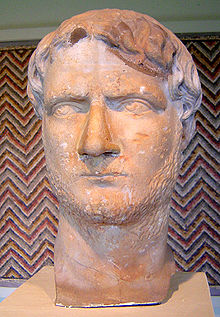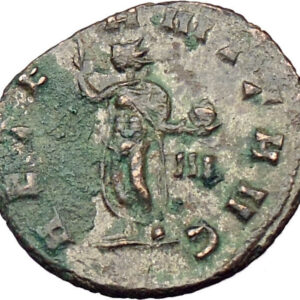|
Gallienus – Roman Emperor: 253-268 A.D. –
Bronze Antoninianus 20mm (2.28 grams) Rome mint, struck 267-268 A.D.
Reference: RIC 207f
GALLIENVS AVG, Radiate, cuirassed bust right.
IOVI CONS AVG / S, Goat standing left.
Coin Notes:
The goat alludes to Jupiter, whom rode one as a child. The emperor is invoking Jupiter to preserve his rule.
You are bidding on the exact item pictured, provided with a Certificate of Authenticity and Lifetime Guarantee of Authenticity.
 Gallienus – Roman Emperor: 253-268 A.D. Gallienus – Roman Emperor: 253-268 A.D.
( 253-260 A.D. with Valerian I | 260 A.D. with Valerian I and Saloninus | 260-268 A.D. sole reign )
Son of Valerian I and Mariniana | Husband of Salonina | Father of Valerian II and Saloninus
Gallienus (Latin: Publius Licinius Egnatius Gallienus Augustus; c. 218 – 268) was Roman Emperor with his father Valerian from 253 to 260 and alone from 260 to 268. He ruled during the Crisis of the Third Century that nearly caused the collapse of the empire. While he won a number of military victories, he was unable to prevent the secession of important provinces.
Gallienus spent most of his time in the provinces of the Rhine area (Germania Inferior, Germania Superior, Raetia, and Noricum), though he almost certainly visited the Danube area and Illyricum during 253 to 258. According to Eutropius and Aurelius Victor, he was particularly energetic and successful in preventing invaders from attacking the German provinces and Gaul, despite the weakness caused by Valerian’s march on Italy against Aemilianus in 253. According to numismatic evidence, he seems to have won many victories there, and a victory in Roman Dacia might also be dated to that period. Even the hostile Latin tradition attributes success to him at this time.
In 255 or 257, Gallienus was made Consul again, suggesting that he briefly visited Rome on those occasions, although no record survives. During his Danube sojourn (Drinkwater suggests in 255 or 256), he proclaimed his elder son Valerian II Caesar and thus official heir to himself and Valerian I; the boy probably joined Gallienus on campaign at that time, and when Gallienus moved west to the Rhine provinces in 257, he remained behind on the Danube as the personification of Imperial authority.
Sometime between 258 and 260 (the exact date is unclear), while Valerian was distracted with the ongoing invasion of Shapur in the East, and Gallienus was preoccupied with his problems in the West, Ingenuus, governor of at least one of the Pannonian provinces, took advantage and declared himself emperor. Valerian II had apparently died on the Danube, most likely in 258. Ingenuus may have been responsible for that calamity. Alternatively, the defeat and capture of Valerian at the battle of Edessa may have been the trigger for the subsequent revolts of Ingenuus, Regalianus, and Postumus. In any case, Gallienus reacted with great speed. He left his son Saloninus as Caesar at Cologne, under the supervision of Albanus (or Silvanus) and the military leadership of Postumus. He then hastily crossed the Balkans, taking with him the new cavalry corps (comitatus) under the command of Aureolus and defeated Ingenuus at Mursa or Sirmium.The victory must be attributed mainly to the cavalry and its brilliant commander. Ingenuus was killed by his own guards or committed suicide by drowning himself after the fall of his capital, Sirmium.
A major invasion by the Alemanni and other Germanic tribes occurred between 258 and 260 (it is hard to fix the precise date of these events),probably due to the vacuum left by the withdrawal of troops supporting Gallienus in the campaign against Ingenuus. Franks broke through the lower Rhine, invading Gaul, some reaching as far as southern Spain, sacking Tarraco (modern Tarragona).The Alamanni invaded, probably through Agri Decumates (an area between the upper Rhine and the upper Danube), likely followed by the Juthungi. After devastating Germania Superior and Raetia (parts of southern France and Switzerland), they entered Italy, the first invasion of the Italian peninsula, aside from its most remote northern regions, since Hannibal 500 years before. When invaders reached the outskirts of Rome, they were repelled by an improvised army assembled by the Senate, consisting of local troops (probably prǣtorian guards) and the strongest of the civilian population.On their retreat through northern Italy, they were intercepted and defeated in the battle of Mediolanum (near present day Milan) by Gallienus’ army, which had advanced from Gaul, or from the Balkans after dealing with the Franks.The battle of Mediolanum was decisive, and the Alamanni didn’t bother the empire for the next ten years. The Juthungi managed to cross the Alps with their valuables and captives from Italy. An historian in the 19th century suggested that the initiative of the Senate gave rise to jealousy and suspicion by Gallienus, thus contributing to his exclusion of senators from military commands.
Gallienus was not treated favorably by ancient historians, partly due to the secession of Gaul and Palmyra and his inability to win them back. According to modern scholar Pat Southern, some historians now see him in a more positive light.Gallienus produced some useful reforms. He contributed to military history as the first to commission primarily cavalry units, the Comitatenses, that could be dispatched anywhere in the Empire in short order. This reform arguably created a precedent for the future emperors Diocletian and Constantine I.
The biographer Aurelius Victor reports that Gallienus forbade senators from becoming military commanders. This policy undermined senatorial power, as more reliable equestrian commanders rose to prominence. In Southern’s view, these reforms and the decline in senatorial influence not only helped Aurelian to salvage the Empire, but they also make Gallienus one of the emperors most responsible for the creation of the Dominate, along with Septimius Severus, Diocletian, and Constantine I.
By portraying himself with the attributes of the gods on his coinage, Gallienus began the final separation of the Emperor from his subjects.A late bust of Gallienus (see above) depicts him with a largely blank face, gazing heavenward, as seen on the famous stone head of Constantine I. One of the last rulers of Rome to be theoretically called “Princeps”, or First Citizen, Gallienus’ shrewd self-promotion assisted in paving the way for those who would be addressed with the words “Dominus et Deus” (Lord and God).
|





 Gallienus – Roman Emperor: 253-268 A.D.
Gallienus – Roman Emperor: 253-268 A.D.




